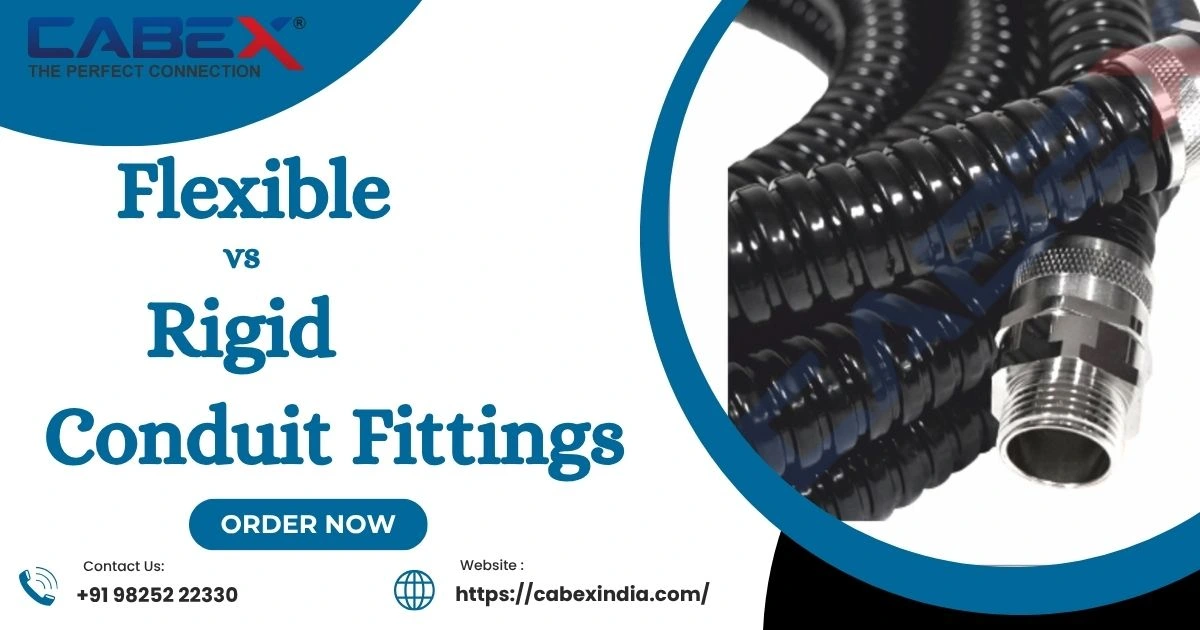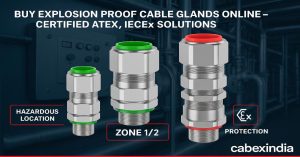When designing an electrical system, selecting the right conduit fittings is as essential as choosing wires themselves. The Flexible vs Rigid Conduit Fittings debate affects safety, longevity, cost, and ease of installation. At Cabex India, we encounter many professionals who undervalue this choice—only to face failures, compliance issues, or higher maintenance later. In this article, you’ll gain clarity and confidence to choose the correct fitting type for your project or purchase decision.
What Are Flexible and Rigid Conduit Fittings?
Definition of Flexible Conduit Fittings
Flexible conduit fittings are connectors and joiners designed to work with flexible conduits—ones that bend easily and adapt to tight or curved pathways. These fittings allow movement, vibration absorption, and easier routing around obstacles. They often come with compression, swivel, or gland-type joints.
Definition of Rigid Conduit Fittings
Rigid conduit fittings join solid, non-bendable conduits (e.g. rigid metallic conduit or rigid PVC). These fittings resist bending and provide mechanical protection. They include couplings, bends, elbows, locknuts, and conduit bodies—sturdy parts built for permanency and robustness.
Materials, Designs & Standards in 2025
Common Materials (Metallic, Non-metallic)
- Metallic: Steel, stainless steel, aluminum, or galvanised metals are common for rigid fittings.
- Non-metallic: PVC, HDPE, nylon, or PA (polyamide) often used for flexible conduits.
- Hybrid designs: Armored flexible conduit (e.g. steel wire over polymer core) offers flexibility with strength.
Design Advances & Trends
- Smart/conductive coatings: Some new flexible fittings include embedded shielding or EMI/RFI suppression layers.
- Lightweight alloys / composites: Especially for renewable energy and solar farms, lightweight rigid fittings are gaining traction.
- Toolless locking systems: Snap-in or quick-lock flexible connectors reduce installation time.
International and Indian Standards
Standards like IEC 61386, NEC (National Electrical Code), and IS codes (e.g., IS 9537 for ISI-marked conduits) guide fitting dimensions, current ratings, flame resistance, and more. Always confirm that your fittings comply with Indian regulation (BIS, IS) and international norms, especially when importing from suppliers like Cabex India.
Flexibility vs Strength: Pros & Cons
Advantages of Flexible Conduit Fittings
- Easy routing: Navigates complex pathways without many joints.
- Vibration absorption & movement: Ideal in machinery or seismic zones.
- Fewer fittings needed: Reduces joints and leak points.
- Time savings: Faster installation in retrofit or confined areas.
Advantages of Rigid Conduit Fittings
- High mechanical protection: Shields cable from impact.
- Stability and permanence: Less susceptible to deformation over time.
- Cost per unit length often lower for conduits: For straight runs, rigid systems may be more economical.
- Better grounding path (in metallic types): Provides solid continuity.
Drawbacks & Limitations
Flexible fittings drawbacks:
- Less mechanical protection against impact or crushing.
- Typically more expensive per unit.
- May loosen over time under cyclic stress.
Rigid fittings drawbacks:
- Harder to route around obstacles (requires elbows, more joints).
- More labor and precision needed for installation.
- Not ideal where movement or vibration is common.
Use Cases & Application Scenarios
Industrial Installations
Machinery, conveyors, and plant floors often involve vibration, thermal expansion, and movement. Flexible fittings mitigate stress and wear in dynamic zones. Rigid conduit fittings dominate long, straight runs or fixed support areas for protection.
Commercial & Residential Wiring
In buildings, rigid fittings (especially rigid PVC) are common in walls, ceilings, and exposed conduit runs. Flexible fittings are used near junction boxes, fan coil units, or where bends are tight or unpredictable.
Harsh, Outdoor & Renewable Energy Sites
Solar farms, wind turbines, or outdoor telecom towers require fittings that resist UV, corrosion, temperature swings, and movement. Flexible armored fittings are great near joints or dynamic segments, while rigid fittings cover fixed spans with heavy protection.
Selection Criteria: How to Choose
Environmental Conditions
- Temperature extremes: Use temperature-rated PVC flexible conduit? or metal fittings with thermal ratings.
- Chemical exposure / corrosion risks: Choose corrosion-resistant materials.
- UV, moisture, ingress: Look for IP ratings, gasketed fittings, and sealing.
Mechanical Protection & Loads
If the conduit will bear external stress or be in high-traffic zones, rigid fittings often win. Where movement, expansion, vibration or shifting occurs, flexible fittings suit better.
Cost, Labor & Maintenance
Factor total installed cost—not merely material prices. Flexible fittings may cost more material but save labor. Consider lifecycle and maintenance too.
Compatibility & Accessories
Check compatibility with conduit fittings and accessories like connectors, locknuts, seals, adapters. Always ensure matching diameters, threads, and types.
Comparative Table: Flexible vs Rigid Conduit Fittings
| Feature | Flexible Conduit Fittings | Rigid Conduit Fittings |
| Flexibility / Movement | High | Low |
| Mechanical Protection | Moderate | High |
| Ease of Installation | Easier in tight/complex paths | More labor for bends/joints |
| Cost (Material + Labor) | Higher material, lower labor in many cases | Lower material, possibly higher labor |
| Durability under impact | Less robust | Very robust |
| Grounding continuity (metal) | May require bonding | Integral metallic path |
| Preferred Applications | Dynamic, vibration-prone zones | Fixed, exposed spans, long runs |
Installation Tips & Best Practices
- Always support conduits at proper intervals—particularly flexible runs to avoid sagging.
- Use bend radii per manufacturer specs—exceeding tight bends can damage cables.
- Seal joints and use gasketed fittings in outdoor or wet environments.
- For mixed systems (flexible + rigid), use proper transition couplers that maintain continuity.
- In metallic flexible systems, ensure bonding or equipotential grounding to avoid stray currents.
- Document conduit runs, bends, and fittings—make maintenance easier.
Conclusion
Choosing wisely between Flexible vs Rigid Conduit Fittings is more than just a technical decision it determines safety, cost, maintenance, and longevity. Each type has its place, and the best outcomes come when you match the fitting to environmental, mechanical, and installation criteria. Vendors like Cabex India provide certified ranges and expert support to help you get it right. Stay updated every 6-12 months, revisit standards, material innovations, and market offerings. That way, your conduits and fittings stay efficient, safe, and future-ready.
FAQ’s
Q: Which is safer, flexible or rigid conduit fittings?
A: Safety depends on use-case. Rigid fittings offer stronger mechanical protection, while flexible ones reduce stress on cable in dynamic environments. Use based on context.
Q: Can I mix flexible and rigid conduits in a run?
A: Yes—transition fittings exist. Ensure that coupling maintains seals and mechanical/electrical continuity.
Q: Do flexible fittings cost more?
A: Typically yes in sheer material cost, but might save labor costs and long-term maintenance.
Q: Is PVC flexible conduit allowed in outdoor installations?
A: Yes, if rated for UV, temperature, and conforming to standards. You might read about “PVC flexible conduit?” in materials catalogs—they can work in many scenarios with proper rating.
Q: How often should I inspect conduit installations?
A: At least every 6–12 months, especially in harsh or dynamic zones.





